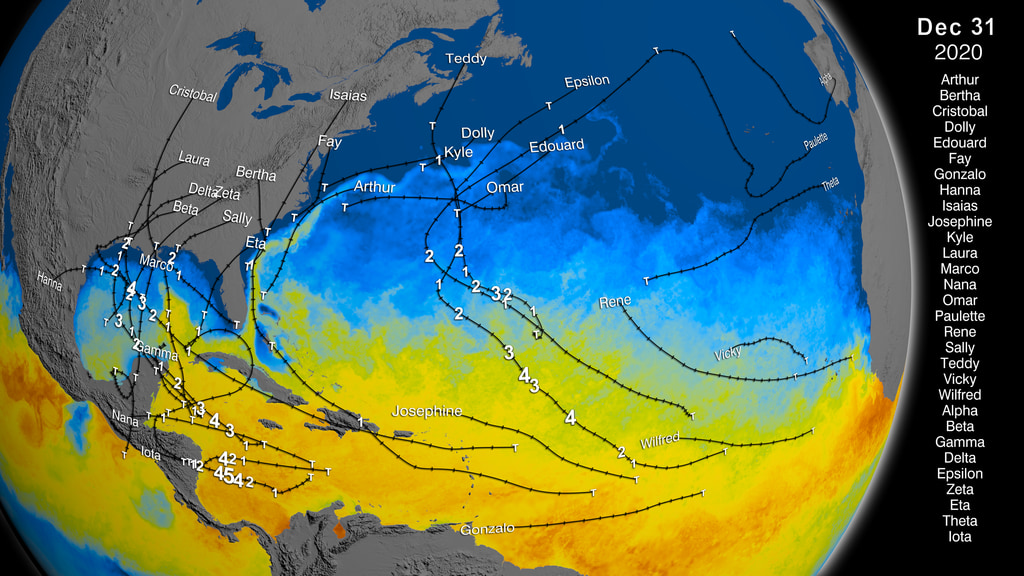NASA follows Hanna to the South Texas Coast
This data visualization shows Hurricane Hanna on July 25, 2020 as it makes landfall on the southern Texas coast.
After forming from a tropical easterly wave in the central Gulf of Mexico, Tropical Depression #8 had intensified enough by the evening of July 21st to be named Tropical Storm Hanna by the National Hurricane Center (NHC) and in the process became the earliest 8th named storm in an Atlantic season on record. As Hanna made its way westward from the central Gulf towards the South Texas coastline, it was constantly being monitored by an array of satellites. This animation shows Hanna’s progression from a tropical storm in the western Gulf of Mexico to a strong Category 1 hurricane at landfall on the South Texas coast using NASA’s IMERG rainfall product. With IMERG, precipitation estimates from the GPM core satellite are used to calibrate precipitation estimates from microwave and IR sensors on other satellites to produce half-hourly precipitation maps at 0.1o horizontal resolution. The start of the animation shows Tropical Storm Hanna on the evening of July 24th spinning counterclockwise in the western Gulf. Hanna’s surface rainfall pattern is rather asymmetric with a broad area of heavy rain southeast of the center with several rainbands wrapping up into the northern Gulf Coast on the east side of the storm. As Hanna continues westward towards Texas, the storm becomes more symmetric with heavy rain starting to wrap around the eastern side of the storm while an eye develops, both of which indicate that the storm is intensifying. Indeed, on the morning of July 25th, NHC reported that Hanna had reached hurricane intensity, becoming the first of the season. Hannah continued to strengthen until making landfall later that same day around 5 pm (CDT) over Padre Island as a strong Category 1 storm with sustained winds reported at 90 mph by NHC. This is reflected in the final part of the animation, which shows an overpass from the GPM core satellite, which overflew the storm around 22:26 UTC (5:26 pm CDT) just after it made landfall. Here rainfall rates derived directly from the GPM Microwave Instrument (or GMI) provide a detailed look into Hanna and show a very well-defined eye surrounded by a complete eyewall containing heavy to very heavy rain rates in nearly every quadrant of the storm. These structural characteristics reflect a strong, well-defined circulation and suggest Hanna quite likely would have reached Category 2 intensity had it remained over open water much longer.
GPM data is archived at https://pps.gsfc.nasa.gov/

Color bar for frozen precipitation rates (ie, snow rates). Shades of cyan represent low amounts of frozen precipitation, whereas shades of purple represent high amounts of precipitation.

Color bar for liquid precipitation rates (ie, rain rates). Shades of green represent low amounts of liquid precipitation, whereas shades of red represent high amounts of precipitation.
Credits
Please give credit for this item to:
NASA's Scientific Visualization Studio
-
Data visualizers
- Alex Kekesi (Global Science and Technology, Inc.)
- Greg Shirah (NASA/GSFC)
-
Scientists
- George Huffman (NASA/GSFC)
- Dalia B Kirschbaum (NASA/GSFC)
-
Producers
- Ryan Fitzgibbons (USRA)
- Jefferson Beck (USRA)
-
Writer
- Stephen Lang (SSAI)
Release date
This page was originally published on Wednesday, July 29, 2020.
This page was last updated on Wednesday, November 15, 2023 at 12:16 AM EST.
Missions
This visualization is related to the following missions:Series
This visualization can be found in the following series:Datasets used in this visualization
-
CPC (Climate Prediction Center) Cloud Composite
ID: 600Global cloud cover from multiple satellites
See all pages that use this dataset -
Rain Rates (Surface Precipitation) [GPM: GMI]
ID: 822Credit: Data provided by the joint NASA/JAXA GPM mission.
See all pages that use this dataset -
Volumetric Precipitation data (Ku) [GPM: DPR]
ID: 830Credit: Data provided by the joint NASA/JAXA GPM mission.
See all pages that use this dataset -
IMERG
ID: 863This dataset can be found at: http://pmm.nasa.gov/sites/default/files/document_files/IMERG_ATBD_V4.4.pdf
See all pages that use this dataset
Note: While we identify the data sets used in these visualizations, we do not store any further details, nor the data sets themselves on our site.

![Music: "Images Grow" by Andrew Michael Britton [PRS] and David Stephen Goldsmith [PRS] Complete transcript available.](/vis/a010000/a013600/a013675/13675_Still_Image.jpg)